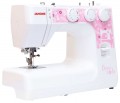Loop formation
The method of loop formation supported by the machine.
-
Automatic. Fully automatic loop formation; the user only needs to set the length, after which the machine will independently process the edges of the future loop, without the need to switch modes manually. The most convenient and advanced option; is the automatic method that is recommended if it is planned to overcast numerous loops.
-
Semi-automatic. When forming a loop in this way, work is done in 2 or 4 steps. For example, in the first case, the machine makes one short bartack and one long longitudinal line in one pass, then the mode switches and the second bartack and the second long line are performed; in the second case, respectively, you have to switch between 4 stages. Such work takes more time than the automatic formation of loops, but such machines are cheaper.
Number of stitches
The number of stitches that a sewing machine can sew. The larger this number, the more extensive the capabilities of this model, the wider the choice the user has; however, it wouldn’t hurt to clarify the specific range of supported stitches separately.
The fewest options - mostly up to 25 - are provided in electromechanical machines, as well as specialized devices such as overlockers and carpet lockers (see “Type”). In computer-controlled devices, the number of lines can be in the dozens, and some also allow you to download additional options from the computer.
Presser foots
Types of presser feet supplied with the sewing machine.
— Universal foot. A foot is used for standard sewing, mainly straight stitches and zigzags.
—
Overlock foot. A foot designed for overlocking. By definition, it is found in devices with an overlock function (see “Type”). However, it can also be provided in traditional sewing machines. In the latter case, such a foot, of course, will not replace a full-fledged overlocker, but in some situations it allows you to work without it.
—
Top feed or walking foot. An additional top-mounted feed dog in place of the stock foot, in addition to the standard bottom feed dog. Such a device makes it easier to work with thin, delicate and sliding fabrics, as well as sewing together several layers of fabric: the material moves as evenly as possible, without distortions and displacements.
—
Zipper foot. The foot for sewing in a zipper can have a different size and design — in particular, there are special devices for sewing in a hidden zipper. The specific features of this device should be clarified separately.
—
Decorative stitch foot. Feet designed for various types of decorative stitching. Such a line may not have a functional role. Its main task is to emphasize a certain element of clothing (edges, pockets, individual seams, etc.). Anyway, the stit
...ch line should usually strictly follow the contour along which it is applied — and this contour can consist of both straight lines and curved lines. Special feet for decorative stitching simplify the task: they are equipped with rulers or other devices that allow you to control the parallelism of the stitches.
— Satin stitch foot. This foot will be suitable for appliqué and other work where zigzag stitches are often used.
— Blind hem foot. Foot designed for blind seams used when hemming the edge of the fabric. It is equipped with a device that provides a hem of the fabric and in this position feeds it under the needle.
— Quilting foot. Special feet for quilting — patchwork. In such works, it is necessary to sew the fabric in several layers, as well as to perform figured seams. In extreme cases, you can use the usual universal foot for quilting, but using a special device is still much more convenient.
— Monogramming foot. The foot for embroidery of monograms will allow you to make embroidery on any object, thereby decorating it with your signature or the emblem of any institution, company, or sports club.
— Buttonhole foot. Buttonhole foot. It eliminates the need for manual work. The sewing machine will do everything for you, which will reduce your time and please you with quality.
— Button sewing foot. A foot is designed to hold the button on the fabric while sewing on. It has a special protrusion pointing down: when the main part of the foot is pressed against the button, this protrusion presses the fabric and prevents it from slipping.
In addition to the above, other types of feet may be included in the delivery kit.Led lighting
A built-in lighting system that illuminates the working table of the machine, which is made of LEDs. In addition to the bright illumination of the work area,
LED-light sewing machines also have lower energy consumption compared to classic lamps.

